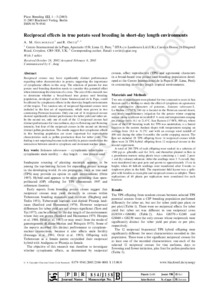Welcome to the International Institute of Tropical Agriculture Research Repository
Journal and Journal Articles: Recent submissions
Now showing items 1381-1400 of 5273
-
Cation exchange capacities of soil organic matter fractions in a Ferric Lixisol with different organic matter inputs
(2003)Soil organic matter (SOM) has an important effect on the physicochemical status of highly weathered soils in the tropics. This work was conducted to determine the contribution of different SOM fractions to the cation exchange capacity (CEC) of a tropical soil and to study the effect of organic matter inputs of different biochemical composition on the CEC of SOM. Soil samples were collected from a 20-year-old arboretum established on a Ferric Lixisol, under seven multipurpose tree species: Afzelia ... -
Regeneration and transient gene expression of African Musa species with diverse genomic constitution and ploidy levels
(2003)An efficient regeneration protocol, which appeared to be independent of ploidy level and genomic background was developed for Musa spp using apical meristems. The selected species represented major groups of Musa including fertile diploid bananas (AA and BB genomes) , the sterile triploid plantain (AAB) , Cavendish bananas (AM), and tetraploid hybrids (AAAA and AAAB). Multiple shoot regeneration was most efficient from explants cultured on Murashige and Skoog medium supplemented with 5 mg L -1 of ... -
CGIAR-future harvest Musa program for Africa
(2003-01) -
Analytical breeding
(2003) -
Effect of Calliandra planting pattern on biomass production and nutrient accumulation in planted fallows of southern Cameroon
(2003)Shortening of fallow periods due to pressure on land by population growth is a common problem throughout the forest zone of West and Central Africa. Crop yields after short-term fallows with natural vegetation are often low as a consequence of low nutrient availability to crops. Planted tree fallows may offer an alternative to natural fallows for improving short fallow-crop cycles if trees accumulate and therefore retain more nutrients in the system. Calliandra calothyrsus (Meissner) (calliandra) ... -
Reaction of cassava genotypes to the cassava mosaic disease in three distinct agroecologies in Nigeria
(2003)Nine cassava genotypes were grown at six representative sites in Nigeria for 3 years to study their response to cassava mosaic disease (CMD), investigate the influence of genotype × environment (G× E) interactions on their reactions to the disease, and identify genotypes with stability to the disease, using the Additive Main Effects and Multiplicative Interaction statistical model. Environments, genotypes and G × E interactions were highly significant (P < 0.01) for the disease. The G × E interactions ... -
Relationship between management practices, fungal infection and aflatoxin for stored maize in Benin
(2003-11)This study relates preharvest and harvest practises to postharvest quality of maize in Benin, West Africa. Fungal infection and aflatoxin levels were evaluated in 300 farmers’ stores in four agro‐ecological zones over 2 years (1993–1995), at the beginning of storage (sample A) and 6 months later (sample B). Aspergillus flavus infected 10–20% of the kernels in sample A (1993–1994). In sample B, 54–79% of the kernels were infected with A. flavus. In 1994–1995, A. flavus infection was higher in sample ... -
Combining ability of tropical maize germplasm in West Africa: IV. Inheritance of resistance to downy mildew (Perenosclerospora sorghi) infection
(2003)Response to downy mildew (DM) attack especially in improved maize varieties is usually erratic when grown in the field. There is need to have a clear understanding of the breeding behavior of maize when infected with DM. A set of diallel crosses obtainecl from nine parents, four resistant and five susceptible lines, was evaluated under artificial infection with DM spores in four environments of Nigeria from 1993 to 1995. Results obtained from these evaluations revealed a highly significant genotype ... -
Association of vertical rootpulling resistance with root lodging and grain yield in selected S1 maize lines derived from a tropical lowNitrogen population
(2003)Root lodging and poor soil fertility are major constraints to maize production in the Guinea savannah of West Africa. Vertical root-pulling resistance is an indicator of the rooting characteristics of maize cultivars and could be used to select cultivars which have higher resistance to root lodging, take up nitrogen efficiently and have high yield. Twenty maize breeding lines were evaluated in the southern Guinea savannah of Nigeria for vertical root-pulling resistance, yield and root lodging in ... -
Assessment of chemical resistance of wild and cultivated Vigna species to the brown pod bug Clavigralla tomentosicollis Stal (Hem., Coreidae)
(2003)The effects of secondary metabolites in different Vigna species on the development of Clavigralla tomentosicollis were investigated in an artificial seed system using different fractions of crude pod extracts, while the orientation response of this pod-bug to volatile extracts was studied using a dual-choice olfactometer. Feeding on the neutral fraction extracts, in contrast to the basic and acidic fractions, resulted in significantly higher mortalities, longer total developmental time, and lower ... -
Relative impact of spider predation and cover crop on population dynamics of Erythroneura variabilis in a raisin grape vineyard
(2003-06)Experimental and correlative evidence has steadily mounted over the past 30 years implicating spiders in the suppression of insect herbivore pests in crop fields. A large body of evidence has also shown that increasing agroecosystem vegetation diversity often influences the abundance of herbivores and their natural enemies. In previous experiments, the abundance of several species of spiders on grapevines in a raisin grape vineyard was twofold enhanced in vineyard plots vegetationally diversified ... -
Reciprocal effects in true potato seed breeding
(2003-06)Reciprocal crosses may have significantly distinct performances regarding tuber characteristics in potato, suggesting the importance of cytoplasmic effects in this crop. The selection of parents for true potato seed breeding therefore needs to consider this potential effect when determining the direction of a cross. The aim of this research was to determine whether a broad-based true potato seed breeding population, developed at the Centro Internacional de la Papa, could be affected by cytoplasmic ...





